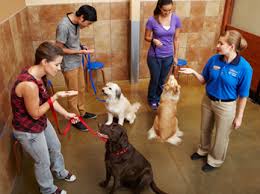Part 1 of the puppy training post left off at crate training basics. The type of training I recommend is based on positive reinforcement. I think it makes for a happier, well-adjusted puppy, and then adult.
More puppy training tips follow that, I think, will help you get on the right track.
Touching your puppy:
Touching your puppy helps develop trust and establish a leadership role in your relationship with the pup. A well-balanced pup will readily allow itself to be touched by its owners and any individual the owner has given the okay to do so. Pups that are either asserting dominance, or are fearful may resist being touched. A potentially dominant acting pup may tense up; growl or even bite if it feels it can be in charge of the relationship. A fearful pup may urinate, whine, pull back or even bite when it is pushed beyond its limits of comfort. One of the reasons for the touching exercises is to help you recognize behavior issues early with your pup. Another is to desensitize the pup for examination.
There will be times when your pup will need to be examined and treated. Pups that have learned to trust people enough to allow themselves to be touched will be less stressed. They will be easier to handle, and some believe they will also feel less pain. Some believe the pups that anticipate pain actually feel it, even if no truly painful procedures are performed. New situations can be very stressful to pups. But a pup that has learned to trust will be more relaxed when it comes time for an exam, or if being groomed.
Initial sessions should involve petting and holding actions. You should touch the ears, face, inner lips, legs and feet. It should become commonplace for them to be handled that way. I say it all the time to new owners, so that cleaning the ears,cutting toenails, or brushing teeth is easier down the road. Put your fingers in his ears, touch the underside and as much of the ear canal as you can softly touch. Even put your fingers in the spaces between his toes. Try to do these exercises regularly. Hold your puppy on his back until there is no struggle when such a position is requested. Do it gently, not forcefully, and ease into it if there is resistance in the beginning. Start for 1-2 minutes multiple times a day until the pup accepts it. Hold him in a secure position in your arms, on the floor, or on a secure and soft surface and not have any sense of falling. The pup that resists is the pup that needs the training the most. End the session before you or the puppy becomes stressed. Do not force. Often, working with the pup when he is sleepy is a good time to deal with a resistant pup.
Teaching manners
I recommend pups of all breeds and sizes go through this training. It bonds them to the family members. It gives them confidence to stand on their own. It develops their mind and a mutual communication between the pup and the family members. They have a natural desire to perform for people they respect. You must learn how to train your pup for him to respect you. You should find that they sleep more peacefully during rest periods, and are calmer when awake. They will be a positive addition to the family.
I think that you should be the one to train your pup. If a trainer is involved, they should come into the home and everyone in the family should all be on the same page. Otherwise, if trained outside of the home, it may not carry over. I do recommend puppy classes with other dogs and families present as well. This is most important when the family has never had a dog they trained before. When pups are old enough for those classes, they should have the basics at home, and then it is important for them to learn with distractions and other animals present. It does you no good to have the pup sit and stay at home, yet forget all the rules the first time you take him to a park and he sees another animal. Let the pup first learn to respect you. Pups tend to learn quickly from trainers, and perform well. They need to learn to respect you and learn from you as well. I do not believe in the schools that take pets for several weeks to “train” them for basic obedience. I have seen plenty of pets go through these sessions, and within a week to a month, are back to their old habits, because they are in their old environment with their untrained owners.
The puppy should have a collar. Early on, small web collars work well. It will take some getting used to. Remove it once the pup quits resisting it. Once he is used to it, it can be left on, and then attached to a lead. Many trainers recommend spraying a lead with a bad tasting spray such as bitter apple. This will help prevent him from chewing the lead. Remember, never to leave a dog in a crate with a collar on, as it can snag on the crate and cause strangulation.
Plan on multiple short sessions daily. They should be fun for you and the pup, ending if you are getting stressed. If the pet is distracted, either the session is too long, or you are not making it exciting enough. Pups get excited about your praise, so do not hold back on it. Play or fun grooming and general happiness should follow each training session.
Treats
Treats are very important. Love and a happy voice are the best treats. Also, edible treats should be small and easy to carry, and interspersed with vocal rewards. Bits of dog biscuits, their regular kibble, dehydrated liver, or pieces of carrot are good examples. You should initially give a treat of some form for every good deed your pup does. However, as training advances, give them less often for the basics and more for the advanced deeds.
Commands
Commands should be preceded by the pup’s name. Say his name in a happy way to attract his attention. Commands should be spoken with an authoritative voice, which is in a lower tone. Women should try to sound like a man. Speak loudly and slowly enough for him to hear and understand that a command has been given. Do not yell at him, and only give commands when you are prepared to help him complete the deed. By this, I mean that you are close enough and in position to help him into the position you are requesting. Give the command only once and do not repeat the command word more than once per exercise. Once the command is given, immediately begin to assist the pup into the position you requested or help him perform the task.
You need a release word. This is a word that your pup should listen for to allow him to once again move about on his own. He should otherwise continue to do what you commanded until released. Words such as “release”, or “okay”, for example, are often used. Try not to select a word used commonly to avoid confusion on his part. At first, you should release your puppy immediately after he has performed your command and when giving the reward. You may also have a release signal, such as both elbows down, but hands up. This will allow you to clap for your pup.
You pup will learn faster than you can. Seriously. He will learn both verbal and physical signals for commands. If you and your family members are consistent with your training, your puppy will master each step in a matter of several lessons. Yet, your pup has a very limited attention span. Initially try to teach him in sessions, less than 1 minute, to eventually 15-30 minute periods of time long by the time they are 6 months old. Pups learn with repetition and consistency. Each family member, generally older than 7 or 8 should try to participate in the training, with some exceptions. Children should be supervised in their handling and training of the puppy.
Hopefully you found these recommendations helpful. Remember, that they are always learning, be it good or bad lessons. The earlier you set them on a good path, the easier ans smoother the transition to your family the pup will make. You will all more fully enjoy him or her sooner. Good luck with your pup.
Dr. Dawn
Please share and subscribe here













